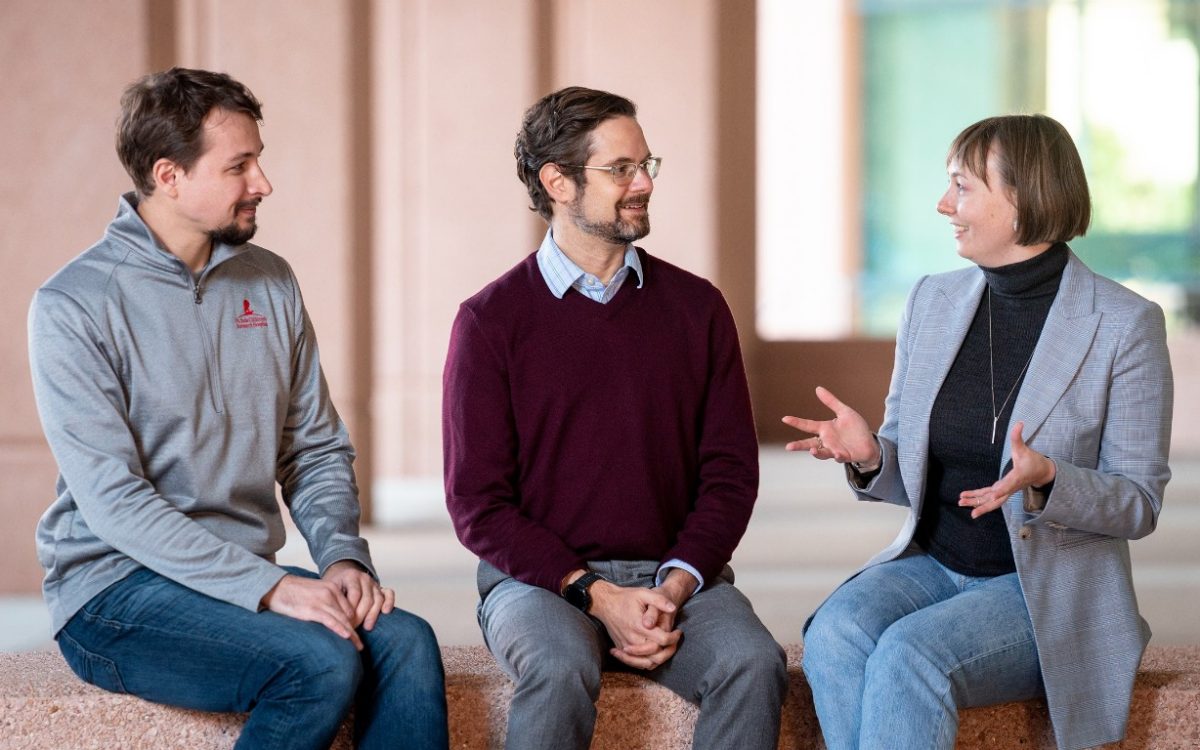
(L to R) Mikhail Pogorelyy, Ph.D., Paul Thomas, Ph.D., and Anastasia Minervina, Ph.D., all with the St. Jude Department of Immunology
Scientists have harnessed T cells to better understand the immune response to mRNA vaccines against SARS-CoV-2, the virus that causes COVID-19.
The findings from St. Jude Children's Research Hospital and Washington University School of Medicine in St. Louis were published today in Cell.
The findings suggest that some aspects of the immune response to mRNA vaccines remain robust six months after vaccination.
Much of the research on immune response to mRNA vaccination has focused on antibody levels, which can be measured by a blood test. However, this is just one aspect of immunity. Researchers wanted to better understand the specificity and structure of the T-cell response to vaccination.
Researchers focused on a certain kind of T cells in the lymph nodes, which facilitate antibody development in vaccinated individuals. The team used samples from Washington University as well as from the St. Jude Tracking of Viral and Host Factors Associated with COVID-19 cohort. The cohort was established in 2020 with St. Jude employees who volunteered to have their immune response to SARS-CoV-2 infection and vaccination monitored.
"Our study lays out a new way of discovering what the T-cell responses are directed against in SARS-CoV-2, and found a surprisingly large T-cell response that is likely shared by over half the world," said co-corresponding author Paul Thomas, Ph.D., St. Jude Department of Immunology. "If your immune system is putting this much effort into seeing that particular piece of the virus, we need a better understanding of that interaction to get a full picture of how the immune system reacts to vaccination."
A more detailed picture of immune response
Different people, and their T cells, identify different parts of the virus thanks in part to hypervariable T-cell receptors. The researchers created an analysis that uses T-cell receptors to guide the scientists to pieces of the virus that the immune system identifies most often. Called reverse epitope discovery, the analysis involves looking at clusters of highly similar T-cell receptors that recognize the virus in a similar way.
The study showed that half of the individuals studied reacted to the same part of the virus and that 10% of their CD4 T cells, which help coordinate the immune response, recognized this piece. That represents a significant T-cell response.
"In general, it is very challenging to track T-cell responses because there is so much diversity," said co-first author Anastasia Minervina, Ph.D., St. Jude Department of Immunology. "We found a way to track the T cells and identified a dominant piece of the virus attracting immune attention in almost half the global population.
"That is a huge response that has largely been missed," she said.
These findings paint a more hopeful picture of lasting immune response to vaccination. While circulating T-cell responses (measured in the blood) might wane in six months, the researchers found that the T cells were still present and active in the lymph nodes, often at levels matching the peak of the response. Additionally, the part of the virus that the T cells are reacting to was not altered in the major SARS-CoV2 variants, including the delta and omicron variants. The approach used in this work could also be used to better understand the T-cell response to other infectious viruses such as influenza.
"An important aspect of this study is that the T cells are showing a stable response," said co-first author Mikhail Pogorelyy, Ph.D., St. Jude Department of Immunology. "Six months after vaccination the immune system is still very active, and the T cells in the lymph node are present at the same level as immediately after vaccination. We haven't been appreciating the whole story about what the immune system is doing."
Authors and Funding
The study's other co-corresponding authors are Ali Ellebedy and Philip Mudd, Washington University School of Medicine in St. Louis. Mudd is also co-first author. Other authors are: Jackson Turner, Wooseob Kim, Aaron Schmitz, Tingting Lei, Elizaveta Kalaidina, Alem Haile, Michael Klebert, Teresa Suessen, William Middleton, Sharlene Teefey, Jane O'Halloran and Rachel Presti, Washington University in St. Louis; Jan Peterson, and Jamie Rossjohn, Monash University; Thi H.O. Nguyen, Louise Rowntree, and Katherine Kedzierska, University of Melbourne; Elisa Rosati, Christian-Albrecht University of Kiel; Katherine Richards and Andrea Sant, University of Rochester Medical Center; and Allison Kirk, Robert Mettleman and Jeremy Chase Crawford of St. Jude.
Additional authors are the members of the SJTRC Study team: Jeremie Estepp, Stacey Schultz-Cherry, Maureen McGargill, Aditya Gaur, James Hoffman, Motomi Mori, Li Tang, Elaine Tuomanen, Richard Webby, Randall Hayden, Hana Hakim, Diego Hijano, Kim Allison, E. Kaitlynn Allen, Resha Bajracharya, Walid Awad, Lee-Ann Van de Velde, Brandi Clark, Taylor Wilson, Aisha Souquette, Ashley Castellaw, Ronald Dallas, Ashleigh Gowen, Thomas Fabrizio, Chun-Yang Lin, David Brice, Sean Cherry, Ericka Kirkpatrick Roubidoux, Valerie Cortez, Pameal Freiden, Nicholas Wohlgemuth and Kendall Whitt, all of St. Jude.
The study was funded by the National Institutes of Health (UL1TR002345), Australian Research Council Laureate Fellowship, NHMRC Leadership Investigator Fellowship, NHMRC Emerging Leadership Level 1 Investigator Fellowship, a Center for Influenza Vaccine Research for High-Risk Populations contract (75N93019C00052), the St. Jude Center for Excellence for Influenza Research and Surveillance contract (HHSN272201400006C), the St. Jude Center for Excellence for Influenza Research and Response contract (75N93021C00016) and grants (U01AI150747, U01AI144616-02S1, R01AI136514), the National Institute for Allergy and Infectious Diseases grants (U01AI141990, U01AI150747) and contracts (HHSN272201400008C, 75N93019C00051); and ALSAC, the fundraising and awareness organization of St. Jude.
Read the full text of the Cell article:
Cell, published online December 23, 2021






